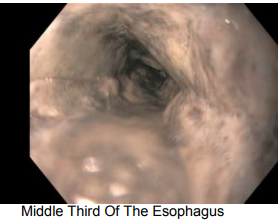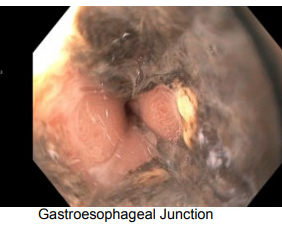Monday Poster Session
Category: Esophagus
P2878 - Black Esophagus in a Patient With Diabetic Ketoacidosis
Monday, October 27, 2025
10:30 AM - 4:00 PM PDT
Location: Exhibit Hall
- PM
Padmavathi Mali, MD (she/her/hers)
Gundersen Health
Onalaska, WI
Presenting Author(s)
Padmavathi Mali, MD
Gundersen Health, Onalaska, WI
Introduction: Acute esophageal necrosis (AEN), also known as “black esophagus,” is a rare but severe condition characterized by circumferential black discoloration of the esophageal mucosa. We present the case of an adult patient with AEN in the setting of diabetic ketoacidosis (DKA), successfully managed with prompt medical therapy.
Case Description/
Methods: A 48-year-old female with a history of type 2 diabetes mellitus presented with nausea, vomiting, and abdominal discomfort. Initial laboratory evaluation revealed a white blood cell count of 28.75 k/µL (3.7–10.4), sodium 123 mmol/L (135–146), creatinine 1.28 mg/dL (0.5–0.9), BUN 48 mg/dL (6–20), CO₂ 6 mmol/L (22–29), an anion gap of 30 mmol/L (6–16), blood glucose of 283 mg/dL, and pH of 7.183 (7.35–7.45). Lactate was 1.3 mmol/L (0.5–2.2), and urine was positive for ketones. She was diagnosed with DKA and initiated on intravenous fluids and insulin therapy. Due to persistent nausea and vomiting, an esophagogastroduodenoscopy (EGD) was performed, revealing circumferential necrosis of the entire esophagus with an abrupt transition at the gastroesophageal junction. Additionally, several non-bleeding duodenal ulcers were noted. The patient was treated with high-dose intravenous proton pump inhibitors, total parenteral nutrition (TPN), and was gradually advanced to a pureed diet. She was discharged with plans for outpatient follow-up and repeat EGD in three weeks.
Discussion: AEN should be considered in critically ill patients with DKA who present with intractable vomiting. In DKA, hypovolemia may lead to reduced perfusion of the gastrointestinal mucosa, including the esophagus, rendering it susceptible to ischemic injury. Additionally, DKA creates a pro-inflammatory and prothrombotic environment, which may contribute to microvascular thrombosis and further compromise mucosal integrity. Reflux of acidic gastric contents due to vomiting exacerbates the injury. Management includes aggressive intravenous fluid resuscitation, gastric acid suppression, and nutritional support with TPN. Complications of AEN include esophageal stricture or stenosis, which develop in up to 15% of cases, typically within 1–3 weeks post-diagnosis.
This case highlights the importance of maintaining a high index of suspicion for AEN in patients presenting with DKA and gastrointestinal symptoms. Early diagnosis and supportive treatment can lead to favorable outcomes in this otherwise life-threatening condition.

Figure: EGD showed circumferential necrosis involving the entire esophageal mucosa

Figure: EGD showed black, necrotic mucosa with a well-defined cutoff at the gastroesophageal junction
Disclosures:
Padmavathi Mali indicated no relevant financial relationships.
Padmavathi Mali, MD. P2878 - Black Esophagus in a Patient With Diabetic Ketoacidosis, ACG 2025 Annual Scientific Meeting Abstracts. Phoenix, AZ: American College of Gastroenterology.
Gundersen Health, Onalaska, WI
Introduction: Acute esophageal necrosis (AEN), also known as “black esophagus,” is a rare but severe condition characterized by circumferential black discoloration of the esophageal mucosa. We present the case of an adult patient with AEN in the setting of diabetic ketoacidosis (DKA), successfully managed with prompt medical therapy.
Case Description/
Methods: A 48-year-old female with a history of type 2 diabetes mellitus presented with nausea, vomiting, and abdominal discomfort. Initial laboratory evaluation revealed a white blood cell count of 28.75 k/µL (3.7–10.4), sodium 123 mmol/L (135–146), creatinine 1.28 mg/dL (0.5–0.9), BUN 48 mg/dL (6–20), CO₂ 6 mmol/L (22–29), an anion gap of 30 mmol/L (6–16), blood glucose of 283 mg/dL, and pH of 7.183 (7.35–7.45). Lactate was 1.3 mmol/L (0.5–2.2), and urine was positive for ketones. She was diagnosed with DKA and initiated on intravenous fluids and insulin therapy. Due to persistent nausea and vomiting, an esophagogastroduodenoscopy (EGD) was performed, revealing circumferential necrosis of the entire esophagus with an abrupt transition at the gastroesophageal junction. Additionally, several non-bleeding duodenal ulcers were noted. The patient was treated with high-dose intravenous proton pump inhibitors, total parenteral nutrition (TPN), and was gradually advanced to a pureed diet. She was discharged with plans for outpatient follow-up and repeat EGD in three weeks.
Discussion: AEN should be considered in critically ill patients with DKA who present with intractable vomiting. In DKA, hypovolemia may lead to reduced perfusion of the gastrointestinal mucosa, including the esophagus, rendering it susceptible to ischemic injury. Additionally, DKA creates a pro-inflammatory and prothrombotic environment, which may contribute to microvascular thrombosis and further compromise mucosal integrity. Reflux of acidic gastric contents due to vomiting exacerbates the injury. Management includes aggressive intravenous fluid resuscitation, gastric acid suppression, and nutritional support with TPN. Complications of AEN include esophageal stricture or stenosis, which develop in up to 15% of cases, typically within 1–3 weeks post-diagnosis.
This case highlights the importance of maintaining a high index of suspicion for AEN in patients presenting with DKA and gastrointestinal symptoms. Early diagnosis and supportive treatment can lead to favorable outcomes in this otherwise life-threatening condition.

Figure: EGD showed circumferential necrosis involving the entire esophageal mucosa

Figure: EGD showed black, necrotic mucosa with a well-defined cutoff at the gastroesophageal junction
Disclosures:
Padmavathi Mali indicated no relevant financial relationships.
Padmavathi Mali, MD. P2878 - Black Esophagus in a Patient With Diabetic Ketoacidosis, ACG 2025 Annual Scientific Meeting Abstracts. Phoenix, AZ: American College of Gastroenterology.
